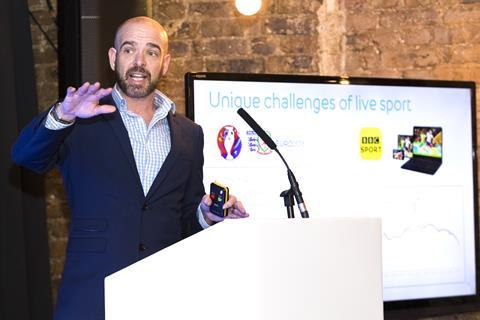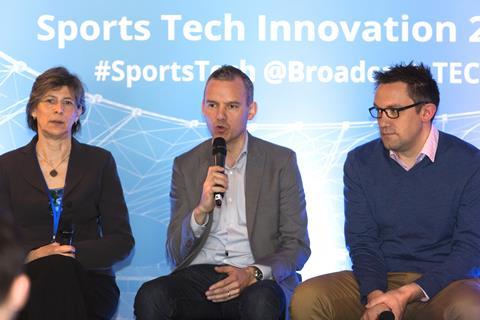Impact of wide colour gamut praised at Broadcast TECH’s first Sports Tech Innovation event
The pros and cons of producing in 4K versus HDR was one of the big talking points at Broadcast TECH’s Sports Tech Innovation event at the Century Club in London last month.
Panellists including BT Sport’s Andy Beale, EE’s Matt Stagg, IMG’s Tim De Marco and Sunset+Vine’s Andrew Preece discussed the impact that a wave of new technology such as 4K, HDR, artificial intelligence (AI), virtual reality (VR), augmented reality (AR) and 5G is having on the sports production industry.

AI’s ability to lower costs and speed up workflows was another key focus, as was the future of VR and the impact of the OTT revolution.
Many of the speakers came out in favour of HDR over 4K in sports production, both because it looks impressive and is easier to deliver, particularly over mobile networks.
“We are not seeing a great deal of demand for 4K yet,” said M2A Media chief executive Marina Kalkanis. She added that many broadcasters are still simply focusing on delivering content in high-quality HD.
The complexity of delivering content in 4K is a key factor preventing its adoption throughout sports production, according to many participants.
Extra payload
Shane Warden, director of broadcast and technology at ATP World Tour tennis producer ATP Media, noted that 4K increases the resolution of the picture by four times:
“This adds way more into the payload for a global travelling circus like us, not only in distribution terms, but also for what we do in archive and editorial.”
Warden said that ATP had 26 feeds broadcasting from last month’s Indian Wells Masters for 14 hours a day over 14 days. “You can’t just go, ‘Let’s turn it on to 4K.’ It is just not feasible.”

He came down firmly on the side of 1080p HDR over 4K. “The biggest bang for our buck in my personal opinion is what we get out of the wide colour gamut of HDR.”
He said HDR is brilliantly suited for covering the mixed weather conditions that tennis tours often face, such as dark afternoon shadow on the court or variation in light as clouds pass in front of the sun.
“HDR and wide colour gamut brings more to the viewer in terms of the match action and gives a real spectacle to the story we are trying to tell. It knocks spots off anything extra pixels will do for us.”
His point was echoed by IMG Studios head of engineering Tim De Marco, who said that HDR simply looks better than UHD.
“Everyone can see it. Show someone HD and UHD and after five minutes looking at the picture, they say, ‘Yes, it does look better.’ Whereas with HDR you get that big immediate, ‘Wow!’”
Matt Stagg, head of media and broadcast at mobile operator EE, said that 4K is prohibitively expensive for consumers to receive over mobile networks because it consumes so much data.

Last month, EE carried out the first ever test of HD HDR live broadcast to mobile devices for the UEFA Champions League clash between Spurs and Juventus. “The optimum for mobile is HD with HDR. You can really see the colours,” said Stagg.
There were defenders of 4K, however. BT Sport has pioneered 4K sports production, launching Europe’s first Ultra HD live sport channel in 2015. Chief engineer Andy Beale said he believes 4K and HDR are entirely complementary.
“We don’t see it as 4K vs HDR. One is about resolution, the other is about dynamic range and wide colour gamut.”
Beale said BT’s decision to broadcast in 4K for the past three years (it has aired about 1,000 games in 4K) has given it a competitive edge. “In the sports world, people always gravitate to the biggest possible screen… and on the big screen, 4K has a place.”
Sunset+Vine executive director Andrew Preece noted that 4K may become more popular when it can more effectively capture complex live events, such as cycle races, marathons and sailing events, that are spread out over long distances.
“RF is a big part of the equation. The big change will come for me when 4K RF capability is fully established, affordable and cost-effective.”
Debate over 4K and HDR dominated the Sports Tech event, and was given extra urgency because of the recent failure of the much-touted 3D format to take off in the sports world.
Failure of 3D
Grabyo chief executive Gareth Capon said there was an expectation that 3D would offer a better viewing experience for viewers, more akin to what VR and AR offers today.
“The experience needs to be better than it was before. Much of what we saw in live 3D sport was considerably worse than what was being put out in HD or below.”
“Live sport is a shared experience,” said All England Lawn Tennis Club (AELTC) broadcast technical manager Tom Giles, explaining why the need for glasses hampered 3D – and why headsets may limit take-up of VR.
Other technologies, particularly AI, AR and OTT, are also having a huge impact on the delivery of sport to viewers. The promise of AI to reduce costs was hotly debated, in particular the way that AI technology can allow production teams to quickly scour archives and automatically create highlights packages.
Kalkanis said AI is “all about lowering operational costs by reducing the number of staff required”.
This could be hugely important at a time when many sports broadcasters and rights holders are going direct to fans with OTT propositions, allowing viewers to watch a much wider range of sports content.
Several panellists said AI could help to lower the cost of delivering all this content. For example, AI can make use of facial recognition technology to track players around the pitch.
However, AI is not yet advanced enough to make strong editorial judgements.
“You can use AI as much as you want to follow players, the ball or even the referee. But it is not going to let you see the man who elbowed that player on the edge of the 18-yard box off-camera,” said Giles. “You need that human intelligence to let you see that from another camera.”
Grabyo’s Capon gave another example of the limitations of AI. “Telling a 14-year-old a story about what is happening on the road to the World Cup is a challenging task [for AI]. Production is not going to move away from people any time soon.”






























No comments yet